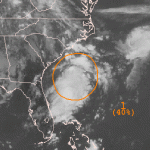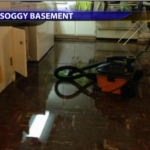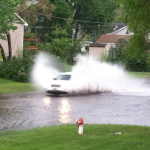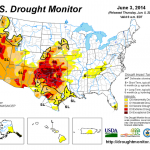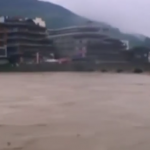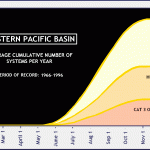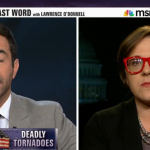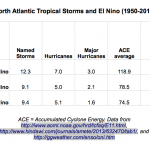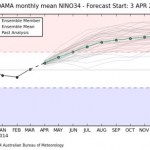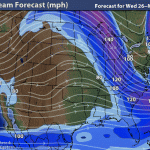Severe weather
There is a stormy thing in the Atlantic that may become a Tropical Storm. It is really just a blob right now, but there is a roughly even chance that over the next two to five days it will form a tropical storm.
No matter what, this blob will menace the US east coast, though it is way too early to say if this will be a big deal or not. It is not entirely clear which direction it will be moving in over the medium term. We will be keeping and eye on it.
We are breaking all sorts of records here in Minnesota this June, and not the records for drought (or, for once, cold). It has been raining and storming a lot, and not just in one place as happens now and then. The rains have been widespread and intensive. The flood levels of most rivers are not breaking records because those are set in the earlier Spring snow-melt driven flooding, but this time of year all the creeks, kills, and rivers should be receding not rising.
The situation is so interesting and important that our local public TV political weekly put the weather on top of the show…
I woke up this morning to find about a dozen reports on my iPad Damage app indicating trees down and hail damage in many communities from Mankato to Edina, south of the Twin Cities. More of the same. We have been having severe weather for about a month now, or a bit less. One day in late May, Julia and I were taking pictures of people driving too fast through the lake that formed in front of our house form a major downpour. Early in that storm we witnessed a ground strike not too far away. A short while after that an ambulance came screaming by our house, coming from the direction of the…
I made a movie you might enjoy. There may be something else out there like this, probably better than this one, but it is still cool. I downloaded all the PDF files from the US Drought Monitor archives, using the version of the connected US that has only the year, month, and day on the graphic. Then I slapped them in iMovie and sped the animation up by 800% over the default 1 sec. per pic. I do not have today's rather horrifying image on it, which I've placed above.
Here's the movie:
Excessive warmth attributable to global warming and a stalled weather system, also attributable to global warming, have caused a weather system in over southeast China to dump rain since May 12th. A million people are in the impacted area, ahlf of them have had to move or have been rescued, and the 2-6 inches of daily rain continues. 25,000 homes have been destroyed.
This area has recieved huge investments over the last few decades, since a huge 1998 storm killed thousands and caused 26 billion dollars in damage. They now fear that the present flooding will be as bad.
Here's some video (…
Usually when I make a sentence like that it is about my wife, Amanda. But this time we're talking about Hurricane Amanda, the first hurricane of the Eastern Pacific hurricane season.
Amanda reached maximum winds of 155 mph on or about 8:00 AM Pacific Daylight Time on Sunday morning. That make Amanda the strongest Eastern Pacific May Hurricane on record. There are usually very few hurricanes in the Eastern Pacific in May, and the few that occur happen late in the months. Here's the historical distribution of Eastern Pacific hurricanes, form 1966-1996:
Amanda is the earliest on record…
This Sunday morning, on Atheist Talk radio, I’ll interview Paul Douglas, America’s favorite meteorologists (at least when the weather is good).
When I first moved to Minnesota, which happened to be during a period of intense Spring and Summer storminess for a few years in a row (including this event which wiped out Amanda’s dorm long before I ever met her), I spent a bit of time while searching for a place to live watching the local news, to get a feel for the place. Coming from the Boston area, where the main local news stations aggressively compete with each other using their…
The US National Weather Service does a pretty good job at predicting weather, but there are problems. In fact, we are behind compared to other nations, and parts of our infrastructure is deteriorating. Paul Douglas has been telling people for some time that we need to pay attention to our aging satellite system, and here Kate Sheppard talks about the slow but steady development of legislation to advance our storm prediction abilities:
I have a little "science by spreadsheet" project for you, concerning the relationship between El Niño and Atlantic hurricanes.
The chance of an El Niño event happening this year seems to go up every few days, with most, perhaps all, climate models suggesting that El Niño will form this Summer or Fall. Climate experts tell us that there are typically fewer hurricanes in the Atlantic during El Niño years. So, I was interested to see how many fewer. Also, there appears to be a different kind of El Niño that happens sometimes, perhaps more often these days as an effect of global warming,…
... and by that I mean the El Niño phase of the El Niño Souther Oscillation climate pattern.
We have been in an ENSO neutral phase for a while. Climate scientists have a hard time predicting El Niño, which arrives in Summer, Fall, or Winter, this early in the year, but nonetheless most prediction sources, and most models, now tell us that we are likely to have one staring, really, any time, but most likely Summer or Fall. Here's a graph of several models. The bottom colored area is Le Niña, who we assume was Jesus Christ's sister, and the top colored area is El Ninño, with the middle part…
The last hurricane season in the Atlantic was anemic, being one of least active periods on record. This was attributed to extra dust blown off the Sahara which inhibits hurricane development.
Right now, the various forecasting agencies around the world are agreeing that there is a greater than 50% chance, perhaps a 70% chance of an El Nino event happening this year, starting in the Summer or Fall. Traditionally, we think of El Nino events as inhibiting tropical storm and hurricane formation in the Atlantic. Today, a group that predicts hurricane activity in the Atlantic every year has used…
Paul Douglas's overview of current wether and climate effects.
Published on Apr 7, 2014
WeatherNationTV Chief Meteorologist Paul Douglas goes over the continuing dangerous drought occurring across the western US. Some places need over a foot of rain just to break even! Is there any relief in sight?
April 27th, I'll be giving a talk hosted by Minnesota Atheists at the Maplewood Library, 3025 Southlawn Dr, Maplewood, Minnesota. Details are here.
Details:
You may attend any part of the meeting you wish, here's the schedule:
1:00-1:15 p.m. – Social Time
1:15-1:45 p.m. – Business Meeting
1:45-2:00 p.m. – Break
2:00-3:30 p.m. – Talk by Greg Laden
4:00-whenever – Dinner at Pizza Ranch (1845 County Road D East, Maplewood MN)
This will be a talk about climate change focusing on current and challenging research questions that everyone needs to know about, as well as the relationship between…
From meteorologist Paul Douglas:
Published on Mar 14, 2014
Weather seems to be staling. Look into how the speed of the jet stream causes this "stuck in a rut" weather pattern. Meteorologist Paul Douglas also takes a look back as to how this winter compares to years past. Checking out extreme drought conditions, snow cover and cooler temperatures overall. This did not only impact the U.S. but other areas of the world. England experienced their wettest winter yet!
Today, Wednesday, an immense storm will move into the Canadian Maritimes after grazing the US East Coast. In the US the storm may severely affect Cape Cod with many inches of snow and hurricane force winds. At sea, in the northern Gulf of Maine and points north, there is a severe risk to boats with very high waves and very severe winds. Halifax could get a foot or two of snow and there will be high coastal waves and strong winds.
This is a rare storm, but of the class of storms that seems to have become more common as the global system of air currents shifts under conditions of global…
Our future is at risk. The science is settled, in the main, though there are many details to continue to work out and there are unknowns. But no one doubts that business as usual release of fossil carbon into the atmosphere mainly as the greenhouse gas Carbon Dioxide spells big trouble for humanity and the planet Earth, including eventual massive sea level rise and highly disruptive changes in the Earth’s climatology that will make a mess of many things including our food supply. Think failed state. Think Syria. Now, think failed planet, Syria over half the globe, the other half merely a mess…
Peter Sinclair has tackled this difficult topic with an excellent video and informative blog post. The blog post is here, and I've pasted the video below.
This is a complicated issue. The water problem in California is obviously made worse by increased demands from population growth and expansion of agriculture. Under "normal" (natural) conditions, California and the American Southwest is fairly dry and can undergo extra dry periods. But climate change seems to be playing a role here as well. It appears that recent lack of rain in the region is the result of changes in atmospheric…
Third warmest in Alaska since records began. Hot in China. Also, we may have a nut shortage. Video from WeatherNation:
Very nice piece on MSNBC's The Reid Report. Spread this around.
Nice job, Michael Mann and Bill Nye.
Nice coverage of climate change that is NOT A "DEBATE" ASSUMING SOME KIND OF DUMB FALSE BALANCE. Way to go, MSNBC. Thank you.
Summer weather in Sochi, a record-drought in California and a polar vortex. The evidence for climate change is all around us. Bill Nye and Jeffrey Sachs talk about the climate debate and need for energy research.
See also this guy:
It is funny that this guy got two people who are also not climate change scientists, but whatever.
